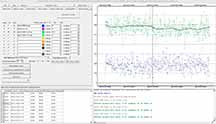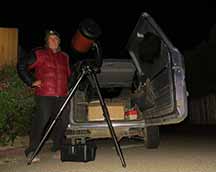

This is a difficult event, but not impossible (I hope). The target is rather blue. I am making this page after finishing my Martschmidt occultation at Cabrillo College Observatory under clear but 97% moonlit skies. I did a GoTo the 1992BX target star to see it's signal, and did a recording of some footage. The target is invisible at 8x or less. It is barely visible at 16x, and it decently visible at 32x. However, at 32x we'd get only 2 integrations inside the occultation. So I'd regard 16x as the longest one should try. I will see if the S/N permits an occultation to be detected. The path goes through downtown Santa Cruz so I don't have to travel any farther than my driveway, nor does Kirk.
I would not advise Karl to try this one with his Watec, the odds of success are too remote. I will probably try it, however, from home.
The altitude is 64 degrees, Az=265 in southern Triangulum. The target will be higher before the event, at 69 degrees about a half hour prior. So be careful in using the f/3.3 reducer too soon to locate the target.
 |
 |
Both Kirk and I got recordings of this event. Not yet looked at. Difficult to see asteroid at 16x which we used, but artful reductions may yet show a 1s long event if we're tight in our apertures.
I observed from home, with moonlight. Had to go to 16x to get the target above sky. There were several single integration drops to zero. At the predicted time, there was a drop but not to zero, and only a single point. Quite consistent with a miss, but not conclusive.
 |
 |
 |
 |
 |
Observed from home just a mile or two cross track from me (RN). His data shows several points at the predicted event time that are low, but not to zero, and gradual drop and rise, not consistent to zero. Suggestive of a short event, but without hardly conclusive and PyOTE cannot detect the event despite diligent tries. Not a clear miss, either. No conclusion.
 |
 |
 |
 |
RN:My suggestion is for both of us to make out reports which just give the start and end times and other data, and "unsure". So, at least the link to this file with light curves is here. I think our light curves at least argue against a full length occultation, and that's of some value perhaps in the future.